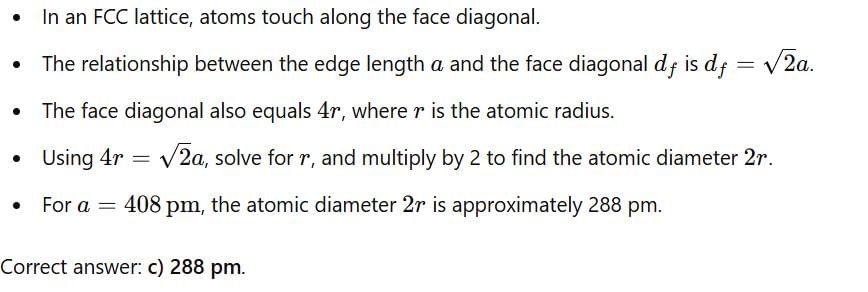Test: Solid State - 3 - Chemistry MCQ
30 Questions MCQ Test Physical Chemistry - Test: Solid State - 3
For a face centered cubic lattice, the miller indices for the first Bragg’s (smallest Bragg angle):
A crystal has the lattice parameters a ≠ b ≠ c and α = β = γ = 900. The crystal system is:
A metal crystallizes in face-centered cubic lattice with a lattice parameter of 4.20 Å. The shortest atom to atom contact distance in the lattice is:
Molybdenum crystallizes in a bcc-structure with unit cell dimensions of 0.314 nm. Considering the atomic mass of molybdenum to be 96, its density (in kg m–3) is in the range of:
For a simple cubic crystal lattice, the angle between the [201] plane and the xy plane is:
For a simple cubic lattice, the ratio between the unit cell length and the separation of two adjacent parallel crystal planes can NOT have a value of:
The unit cell of diamond can be obtained from the unit cell of:
The defect that results when electrons are trapped in an ionic crystal lattice in place of an anion valancy is known as:
Iron (II) oxide, FeO, crystal has a cubic structure and each edge of the unit cell is 5.0 Å. Taking density of the oxide as 4.0 g cm–3. Calculate the no. of Fe2+ and O2– ions present in each unit cell.
Calculate the miller indices of crystal planes which cut through the crystal axis at (2a, –3b, –3c):
Calcium fluoride crystallizes in fluorite structure. The co-ordination no. for the cation and anion is respectively:
The atomic radius (in cm) of an element with a body centred cubit unit cell of molecular weight 137.3 and density 3.62 g cm–3 is:
Which one of the following plane will show allowed reflection for any FCC:
There are two crystal lattice A and B
A: Diffracts from (200) and (111) plane but not from (110)
B: Diffracts from (110) and (100) plane but not from (111)
A metal crystallizes with a face-centered cubic lattice. The edge of the unit cell is 408 pm. The diameter of the metal atom is
The second order brags diffraction from the (100) planes of a cubic crystal is equivalent to:
The correct statement(s) regarding defects in solids is (are):
If the unit cell of a mineral has cubic close packed (ccp) array of oxygen atoms with m fraction of octahedral holes occupied by aluminium ions and n fraction of tetrahedral holes occupied by magnesium ions, m and n, respectively are:
The correct statement(s) for cubic close packed (ccp) three dimensional structure is (are):
Numerical Answer type (Q. No. 28-30)
Silver (atomic weight = 108 g mol–1) has a density of 10.5 g cm–3. The no. of silver atoms on a surface of area 10–12 m2 can be expressed in scientific rotation as Y × 10x. The value of x is…..:
The no. of particle present in octahedral void in ZnS (Blend) structure is:
|
83 videos|142 docs|67 tests
|



















